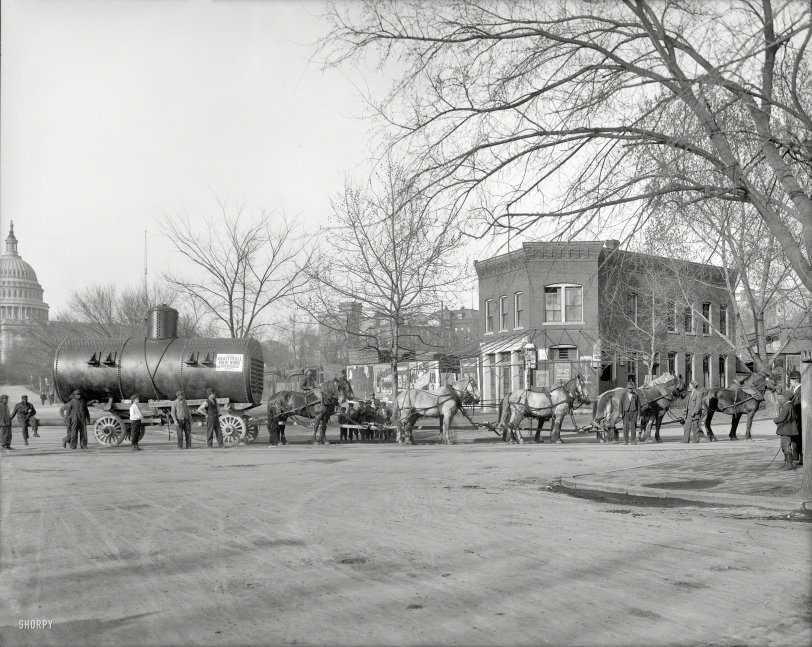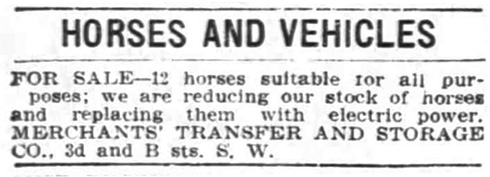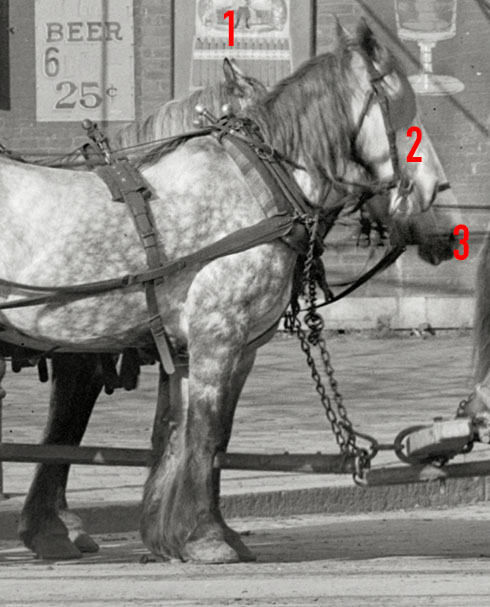


Framed or unframed, desk size to sofa size, printed by us in Arizona and Alabama since 2007. Explore now.
Shorpy is funded by you. Patreon contributors get an ad-free experience.
Learn more.

- Baldwin 62303
- Baldwin VO-1000
- Cold
- No expense spared
- Tough Guys
- Lost in Toyland
- And without gloves
- If I were a blindfolded time traveler
- Smoke Consumer Also Cooks
- Oh that stove!
- Possibly still there?
- What?!?
- $100 Reward
- Freeze Frame
- Texas Flyer wanted
- Just a Year Too Soon
- WWII -- Replacing men with women at the railroad crossing.
- Yes, Icing
- You kids drive me nuts!
- NOT An Easy Job
- I wonder
- Just add window boxes
- Icing Platform?
- Indiana Harbor Belt abides
- Freezing haze
- Corrections (for those who care)
- C&NW at Nelson
- Fallen Flags
- A dangerous job made worse
- Water Stop
Print Emporium
Twelve Horsepower: 1911

"Merchants Transfer & Storage Co., Washington, D.C." In 1911, moving a boiler on D Street within sight of the Capitol with a 12-horse team. Bonus: Many old billboards. Harris & Ewing Collection glass negative. View full size.
Must of wore them plumb out
From the March 5, 1911 edition of The Washington Times:

More
Great photo. As a retired structural engineer I would like to see more photos of turn-of-the-19th-century construction sites when the predominant power sources were men, horses and mules.
Coatesville Boiler Works
Having grown up just next to Coatesville, the town name on the new boiler was the first thing to catch my eye.
The boiler works was most likely associated with (or at least bought their boilerplate from) Lukens Steel, which to this day is the oldest steel mill in commission within the United States.
Extended truck "log" frame under wagon.
Signalman noticed that log to the left. Looking under the wagon you can see the adjustable collar used to extend or shorten the overall wagon length.
This was a heavy haul wagon to start with based on the wheel rim, spoke, and axle sizing. No brakes either, though city hauls would be fairly level and some of the helpers might have been carrying wheel chocks to slow it down during downhill travel.
The Pole
Look at the undercarriage parts in front of the rear wheels...the pole is actually an adjustable chassis/backbone for the wagon, which seems to be adjustable for a load at least twice as long as the boiler with that particular pole. The pole seems adequately supported by the attachments to the axles and held up by the colossal weight of the load.
You can see a simple holder there with what amounts to two huge hoseclamps to hang the axle unit onto the pole. I'm guessing that this is a seldom-used rig for the most awkward loads, and that it was disassembled for storage when not needed.
Large Pole
To me it looks like the long pole the guy is sitting on is part of the trailer. The rear axle is adjustable for longer loads.
But Wait, There's More...
Based on the method of attachment to the pole under the first boiler trailer, the pole could be easily used to attach a 2nd trailer.
More than meets the eye
But wait asked: What is the large pole (leading out of the picture to the left) for?
I think it is part of the wagon and there is more to this drayage than meets the eye, or fits in the picture. There could be a second boiler or more parts in another wagon connected to the visible wagon via said pole.
Baseball
Looks like perhaps that group of boys behind the horses, stopped their baseball game to gaze on all of that horsepower. Either that, or they lost their baseball diamond with all of the commotion. (For what it's worth, I think there might be a 13th horse in the second group from the back... an awful lot of legs. But perhaps they are ghost legs).
Now That's Entertainment!
One of the many things that make SHORPY such a great site is the interaction of the commenters and Dave and tterrace. Not only do we get to see great old pictures, but on occasion we become privy to folks getting confused, or being mistaken, or just plain flummoxed by the pictures.
Such fun!
SHORPY is always good entertainment; always good for a grin, or a chuckle, or a good ol' belly laugh! Thank you to all the commenters for their input, whether confused or not. You make the day for so many people.
And to Dave and tterrace, keep the pictures and the comments coming!
But Wait - There's More!
What is the large pole (leading out of the picture to the left) for? The fellow sitting on the pole would seem to suggest that it is well supported out of the picture.
Cameo
Did anyone else notice the Alfred Hitchcock lookalike looking out from behind the bars of the window in the bar?
Delaware Avenue
The cross street is most likely Delaware Avenue. The Statue of Freedom on the dome faces east, which means we're on the south side of the Capitol (remember, there's a D Street on the north side, too). The cross street aims directly at the southwest corner of the Capitol Building, which, if it still extended that far, Delaware Avenue would do. The majority of the road is gone now. It is a huge parking lot to the southwest and the Rayburn House Office Building to the Northeast. What remains of it is a security screening area for delivery trucks waiting to enter the loading docks of one of the house office buildings.
Oversize Load, 1.0
Very impressive example of the way large loads were moved back in the day. And no signs were needed to indicate the obvious, either.
Yep, Twelve
You can see the nose band on the blurred nose of the middle horse in the second team of three and three pairs of hames in the first triple team. It's an odd setup, usually seen only on fire engine teams, but what probably happened was they needed the added horsepower, but the two extra horses may not have teamed well together but worked well with the other teams. Normally, teamsters would have simply doubled the wheel team (closest to the the load). I guess they had their reasons for this configuration. It may be that those middle teams tended to drift and the third horses were there to keep them straight. I noticed that the only mounted driver is on the wheel team. Often there would be at least another driver on the near lead horse. In the old horse drawn artillery, there was a driver on each pair.
There Are Clearly 10
Even in the "close up" from mailman7777777 you can clearly see that there are 2 horses not 3. Unless the horses are magical semi-transparent horses.
What is 3 is just a horse that moved a bit in a long exposure.
Come on people!
[Horse 3 has a noseband, horse 2 does not. The exposure wasn't long enough for horse 1 to have moved that far. Horse 3 merely bobbed its head quickly during the exposure. Dave posted the closeup. -tterrace]
[There are also three horses in the second group from the right -- three rumps and three tails at one end, and three necks and six ears at the other. Sarabellum might also want to count the legs.- Dave]

D Street and Delaware Ave SW
The Statue of Freedom atop the Capitol faces east, and we're a little off the diagonal from the top of the Capitol and the SW corner of the building. The view from the same spot today is blocked by the Rayburn House Office Building.
Military precision
All those horses have their front hooves together but one slacker in the rear. That makes it easy to count but is that boiler full of water requiring lots of horse power or are they going a long way?
Three
There looks to be three horses in the second bunch from the right, but nowhere else.
[Three heads plus six forelegs = three horses in the middle group, too. - Dave]

Spare Horses?
Unless there a pair of horses bringing up the rear and out of view -- I only see 10 horses (5 pairs).
[See below, and above. A more interesting question might be: What is the cross street here? - Dave]
Twelve?
Upon a cursory look, I only spy ten horses.
[2 + 2 + 3 + 3 + 2 = 12 - Dave]
I agree but a cursory look should exonerate me from this foo-pah...
Cheap buzz
Six beers for a quarter should just about do it. Is the bar open yet?
























On Shorpy:
Today’s Top 5